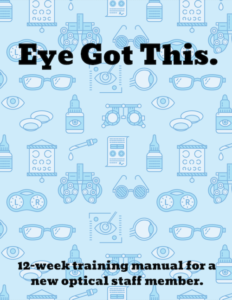

In her second year, she hired her first staff member who had no optometric experience whatsoever. Her first task as a now-manager of someone else was to write a manual. “The manual outlined what I expected of her,” she says. “It covered how to pull up benefits and submit claims to every insurance we took at the time, how to order contacts and several more front office tasks.”
In 2015, Dr. Amato left the optical boutique and opened Sight Eyecare, her own private practice. At this time, her manual grew quite a bit longer. “Adding in ownership of the optical made training a new staff member far more complex. There is just so much to learn, and I found it difficult to know where to even begin with training since most applicants were coming in with no optical experience,” she notes.
MANUAL ADDS CONTINUITY
Now Dr. Amato has taken pen to paper again, but this time has rewritten her manual, Eye Got This, in a way that can be of use to others. “I felt there was a need in the industry for something like this,” she says. “It’s a niche book–it won’t work for all.” She notes her practice model is specific: a cold start with one to two staff members who are cross-trained to do nearly everything. The book covers a lot of processes. “It goes through them in a way that’s methodical over the course of 12 weeks (one chapter per week). “It’s a 12-week training period that coincides with a traditional probationary/training period.”

Dr. Amato stresses that while the book has many tips on her own learned best practices, there are also things it is not. “It is not a How to Be an Optician book, but it’s a starting point,” she says. Dr. Amato has laid out best practices for interacting with patients, selling contact lenses and communicating pricing. About 20 percent of the content references VSP and EyeMed and how to navigate those specific plans.
After talking to her colleagues and finding a gap in the market for these sorts of guides, one common thread she found was that many practice owners felt frustrated with their staff members for doing things a certain way, especially with sales. Dr. Amato sees it from a big-picture perspective. “That comes back to the manager and lack of training,” she says. “If staff isn’t doing it right… maybe we haven’t trained them right in the first place.”
A SOLID PLACE TO START
Dr. Amato urges readers of the manual to remember that there are no works of advice that are one-size-fits-all. “There’s an icon in the book that indicates whenever the new hire needs to, ‘Ask the manager,’” she says. [“This is for] where practices differ. What is your practice’s stance on promoting blue blocker lenses? What do you do if someone calls with emergency issues?” Dr. Amato, for example, likes to get on the phone with the emergency patient herself whenever possible, and her staff helps to make that successful, but she notes that every office may have its own approach. Thus, the stopping point icons in the manual remind a new employee to check-in with a manager during the course of their training.
GETTING CONVERSATIONS STARTED
A conversation-starting aspect of the book is the inclusion of over 200 quiz questions … with no “right” answers. “Each practice does things differently,” she says. “There are a few sections that include patient scenarios, in which new hires are given different patient ages, occupations and prescriptions and is asked to present what lens options they recommend for those particular patients, along with pricing. There is not necessarily a right or wrong answer with these sections. I’m not trying to make it prescriptive, but I do want to encourage conversation and encourage staff members to think their way through various scenarios, since I feel that this is generally the best way to learn.”
In her own practice, Dr. Amato has found immense success with the manual’s implementation. “My two main staff members who have been with me for five plus years have reviewed this, and one commented, ‘How could anyone have a hard time working here and learning how to do their daily tasks? There’s very little training required once someone reads your manual. It literally outlines how to authorize and submit to every insurance plan step-by-step. ”
LEARN MORE
Dr. Amato’s manual, Eye Got This, is for sale in print. Readers visiting the website can read a preview and have access to the table of contents. “I don’t want people to buy it if it’s not useful to their particular practice,” she says. “The goal eventually is to make this customizable, so practice managers or doctors can add in the insurances they take, the progressives they recommend and more.” For now, though, Dr. Amato hopes that this will help newer practices shorten the learning curve and create a more predictable process for training their front office staffs.



